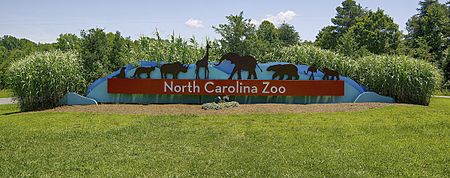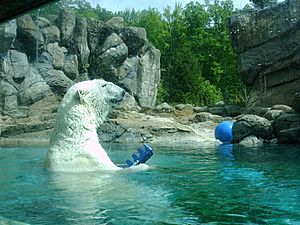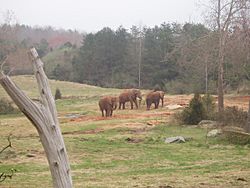North Carolina Zoo facts for kids

The park's entrance sign
|
|
| Date opened | August 13, 1974 |
|---|---|
| Location | Asheboro, North Carolina, United States |
| Land area | 2,600 acres (1,100 ha) total 500 acres (200 ha) developed |
| Coordinates | 35°37′46″N 79°45′52″W / 35.6295°N 79.7645°W |
| No. of animals | 1,800+. |
| No. of species | 250. |
| Annual visitors | 860,000. |
| Memberships | NC Zoo Society |
| Major exhibits | Rocky Coast, Kitera Forest, Mountain Ridge and Valley, Forest Glade, Desert, Watani Grasslands Reserve, Aviary, Northwoods, Streamside, Cypress Swamp |
| Website | NC Zoo |
The North Carolina Zoo is a huge and exciting place to visit! It's located in the middle of North Carolina, near Asheboro. This zoo covers a massive 2,600 acres (1,100 ha) of land. About 500 acres (200 ha) of this land is developed for animal habitats and visitor areas. It's known as the world's largest zoo that focuses on natural habitats. The North Carolina Zoo is supported by the state government.
The idea for the North Carolina Zoo started in 1967. Today, it's about 75 miles (121 km) west of Raleigh and 25 miles (40 km) south of Greensboro. The zoo is home to over 1,800 animals from more than 250 different species. Most of these animals come from Africa and North America. The zoo is open almost every day of the year, closing only for Thanksgiving and Christmas. More than 900,000 people visit the zoo each year! It is also officially recognized by the Association of Zoos and Aquariums.
Contents
The Zoo's Story: How it Began
In 1967, leaders in North Carolina started thinking about a state zoo. They created a special group to see if a zoo was possible. This group decided that a zoo was a great idea! The next year, the North Carolina Zoological Society was formed. This group helped raise money and get people excited about the zoo.
The zoo's location in Randolph County was chosen after a two-year search. Over 1,371 acres (5.55 km2) of land was given to the state for the zoo. In 1972, construction began. The first animals, two Galapagos tortoises, arrived in 1973. A small "Interim Zoo" opened in 1974. The official grand opening of the North Carolina Zoo was on August 13, 1976.
Growing the Animal Habitats
Work on the Africa region began in 1976. The first five African habitats opened in 1980. Today, this area is home to amazing animals like chimpanzees, giraffes, gorillas, zebras, and elephants.
In 1978, Ham the Chimp came to the zoo. Ham was famous for being the first chimpanzee in outer space! He lived at the zoo until he passed away in 1983.
The zoo has continued to grow over the years. In the 1980s, more Africa habitats opened. In 1984, the zoo received its official accreditation from the Association of Zoos and Aquariums (AZA). This means the zoo meets high standards for animal care. In 1993, the first North America habitats were finished, starting with the Sonoran Desert area. The full North America region opened in 1996.
Future Growth and Learning
In 2015, a special bond (a way to raise money for projects) was approved. This money will help build a new Asia region at the zoo. The goal is to attract over 1 million visitors each year!
Besides seeing wild animals, the North Carolina Zoo offers many fun ways for families to learn and play. They have lots of nature-based programs and camps too.
Exciting Future Plans for the Zoo
In 2010, the zoo bought more land next to it. This made the total land area over 2,000 acres (8.1 km2)! The main animal habitats currently cover about 500 acres (2.0 km2).
The zoo received money from the Connect NC bond, approved in 2015. In 2018, the zoo announced exciting plans for two new continents: Asia and Australia! The money from the bond will help build the new Asia region.
New Animals Coming to Asia
The Asia region will feature many incredible animals, including:
- Tigers
- Hippos
- Komodo dragons
- Vultures
- Peacocks
- King cobras
- Chinese alligators
- Small-clawed otters
The zoo hopes to start building these new areas in 2020. The Asia region is planned to open in 2023.
Amazing Animals and Habitats

The North Carolina Zoo is home to 1,800 animals from over 200 species. It has one of the largest groups of chimpanzees in any American zoo. It also has the biggest collection of Alaskan seabirds in the country. The zoo is one of the few AZA-accredited zoos in the U.S. with a breeding pair of polar bears. These bears are part of a special program called the Species Survival Plan. This plan helps protect endangered animals.
How the Zoo is Laid Out
The North Carolina Zoo has different sections: Africa, North America, a global Aviary, and a global Desert. There are parking lots at both ends of the Africa and North America sections. This means visitors can start their day from either side. The zoo has about five miles of walking paths. But don't worry, they also have trams and air-conditioned buses to help visitors get around!
The zoo's main idea is to create natural habitats. This means animals live with plants in areas that look like their homes in the wild. For example, the 40-acre (160,000 m2) Watani Grasslands habitat is as big as many entire zoos!
Exploring North America's Wildlife
The Cypress Swamp area is home to alligators, cougars, and many different reptiles and amphibians. Rocky Coast shows what the rocky shores of the Pacific Northwest are like. Here you can see peregrine falcons, polar bears, California sea lions, harbor seals, Arctic foxes, and various seabirds like thick billed murres and horned puffins.
The Streamside habitat shows the streams of North Carolina. You can spot Bobcats, river otters, snakes, and fish. This includes the critically endangered Cape Fear shiner. In the Prairie habitat, you can see bison and elk. Black bears, grizzlies, and red wolves also have their own habitats.
Discovering the Desert
The "Mangum Desert" is a glass-domed area that shows off desert plants and animals. Outside, you might see ocelots. Inside, there are many reptiles like Banded rock rattlesnakes and pancake tortoises. You'll also find birds such as turkey vultures, red-tailed hawks, and laughing kookaburras. A special nocturnal section lets you see animals that are active at night. These include common vampire bats, beaded lizards, sand cats, and sidewinders.
Soaring in the Aviary

The R. J. Reynolds Forest Aviary is like walking into a hot, humid tropical forest. It has over three thousand tropical plants. Visitors can walk among many different kinds of free-flying tropical birds. You might see sunbitterns, Victoria crowned pigeons, Nicobar pigeons, and Asian fairy bluebirds. The Indian peafowl are also beautiful to watch. USA Today even named the North Carolina Zoo's Aviary as one of the best bird exhibits in the U.S.
Journey to Africa

The Forest Edge habitat is a 3.5-acre (14,000 m2) grassland area. Here, you can see zebras, ostrich, and reticulated giraffes. The Watani Grasslands Reserve is huge, covering 47-acre (190,000 m2). It looks like the vast savannas of Africa. This reserve is home to African elephants.
Nearby, southern white rhinos, Thomson's gazelles, gemsboks, and other antelopes share a habitat. It's designed to look like one continuous open space. You can even see the elephants looking out at the rhinos and antelopes! Chimpanzees live in the Kitera Forest habitat. Western lowland gorillas are in the Forest Glade exhibit. African lions, hamadryas baboons, and red river hogs each have their own spaces. Ring tailed lemurs and red ruffed lemurs from Madagascar were added to the Africa region after some updates.
Art Around the Zoo
The North Carolina Zoo has a large collection of art. Most of it is sculpture, but there are also murals, mosaics, and paintings. The artwork usually shows animals and their homes. It's made from many different materials like marble, steel, bronze, and glass. The art helps make the zoo experience more fun and helps people learn.
Two of the biggest sculptures are at the zoo's main entrances. One is called "Sum of the Parts." It's a pile of large metal cubes. Most cubes are shiny and show animals that are still alive today. A few rusted cubes remember animals that are now extinct. The other large sculpture is "The Elephant Group," which shows several big elephants made of bronze. These artworks were put in place in 1998.
Helping Animals: Research and Conservation
The NC Zoo is very involved in projects to study and protect animals.
Conservation in Africa
The zoo works with the World Wildlife Fund and the government of Cameroon. They track elephants using satellite collars to help expand protected areas. This project won an award in 2008! Also in Cameroon and Nigeria, the zoo helps watch the rare Cross River gorilla. This gorilla was once thought to be extinct. The zoo uses satellite images and GPS to map their homes and help rangers protect them.
The zoo also has projects in Uganda. For over ten years, they've had an education project around Kibale National Park. This project teaches young people about the park and why it's important to protect nature. They also support research and help remove illegal traps that can hurt animals.
Protecting North Carolina's Wildlife
Many projects are also happening right here in North Carolina. One project focuses on protecting the hellbender salamander. This salamander is "endangered" in North Carolina. The zoo has done a big survey to find out how many hellbenders are left in western North Carolina.
The zoo is also helping to save the endangered Schweinitz's sunflower. In 2001, a road project threatened these flowers. The zoo worked with others to successfully move the flowers to a safe place. Zoo gardeners continue to care for them.
Species Survival Plans and New Births
Since 1995, the North Carolina Zoo has been part of the American Red Wolf Species Survival Plan. This program helps bring red wolves back into the wild. The zoo is also part of the gorilla Species Survival Plan. In 2010, two female gorillas came to the zoo for this effort. Thanks to their successful breeding, two baby male gorillas, Bomassa and Apollo, were born in August 2012!
The Aviary is also famous for many special bird hatchings. These include the first U.S. hatchings of the golden white-eye and the horned puffin. They also had the second U.S. hatchings of the African grey-headed kingfisher and the African spoonbill.
The North Carolina Zoo has also had success with southern white rhino calves. Two were born in the summer of 2018, and another in January 2020!
How the Zoo is Managed
The North Carolina Zoo is part of the North Carolina Department of Natural and Cultural Resources. A group of 15 people called the Zoo Council helps oversee its operations. The Governor of North Carolina chooses these members. The current director of the North Carolina Zoo is Pat Simmons.
The zoo's yearly budget is about $18 million. About 60 percent of this money comes from the state. The rest comes from ticket sales, merchandise, and donations from the North Carolina Zoological Society. This society is the main group that raises money and handles memberships for the zoo.

